E46 330i Fuel Pressure Test
Discussion
For over a year I've been trying to get to the bottom of my hot start problem.
When the car is stone cold (left for 2 days), it starts perfectly
When the car is cold (left overnight), it starts more or less perfectly, only a slight blip when turning the key
When the car is warm (left more than 5 minutes after turning the ignition off), it becomes harder to start with longer crank times
When the car is warm (left around 3 hours), it becomes very difficult to start with around 5 seconds crank time, and having to use the throttle to get the car started/idling perfectly. (It fires weakly into life but RPM sits around 200-400 RPM, and it needs a blip of the throttle to get to the 650 RPM range where it is then happy)
The car seems fine apart from this annoyance.
At this stage I should add that I have had the car scanned many times including by BMW GT1 scanner and no codes are thrown at all.
In the last year I have changed the fuel filter, crankcase vent valve and all hoses, cleaned the ICV, Throttle body, changed the hoses from MAF down to throttle body/ICV, changed the VANOS seals with the beisan kit and changed all gaskets whilst doing that, serviced the car fully included all filters, oil etc. Changed the transmission and diff oil. Changed the spark plugs. Changed intake and exhaust cam sensors, inspite of no codes being shown, just in case.
So after all that I decided to invest in a fuel pressure gauge and ordered a unit from the US which arrived late last week.
I've just been out to the car to carry out some readings. As far as I am aware (please correct me if I am wrong), the fuel pressure should be 3.5 bar (broadly 50.8 PSI) when the rail is primed by the fuel pump and as far as I am aware there should not be significant degradation in fuel pressure for a good while (I understand 2 hours) after the fuel pump has primed the system.
The fuel pressure gauge attaches to the schraeder valve on the fuel rail as such...
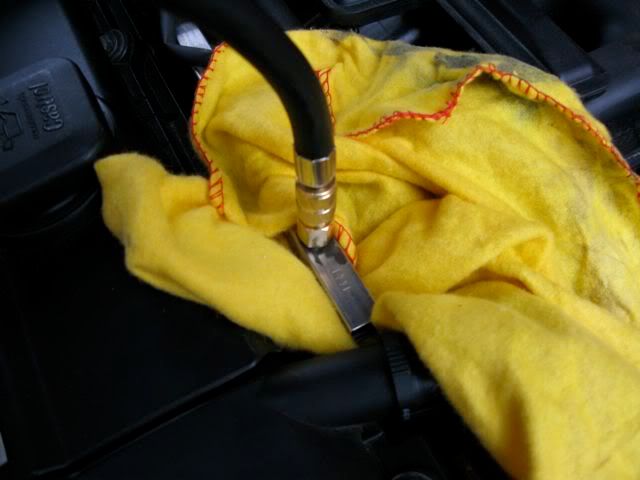
When the car is turned on and idling, the pressure reads broadly what I was expecting...
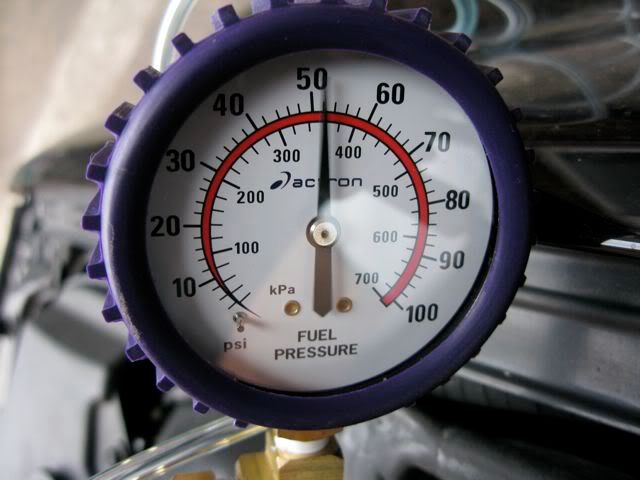
So after this, I switched the car off and then went through a couple of cycles of priming the fuel rail with the whirring of the fuel pump and quickly got a photo of the pressure...
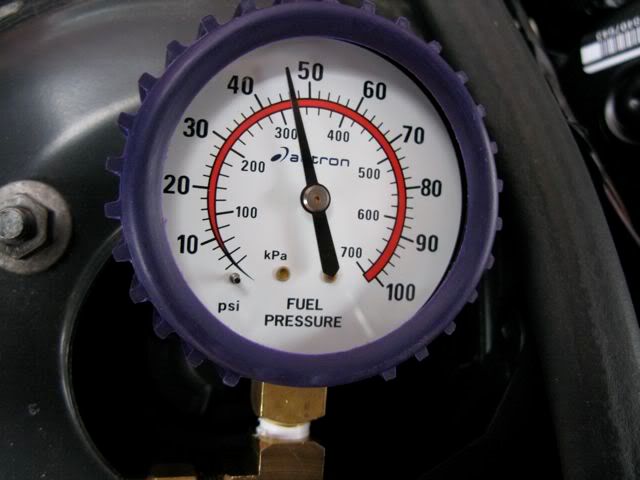
Already in a short time I see the fuel pressure dropping.
After 1 minute we have...
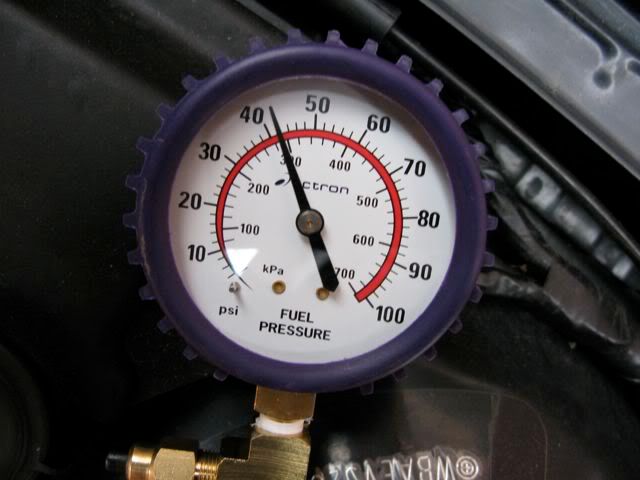
Quite a significant drop in fuel pressure, after 2 minutes we have...
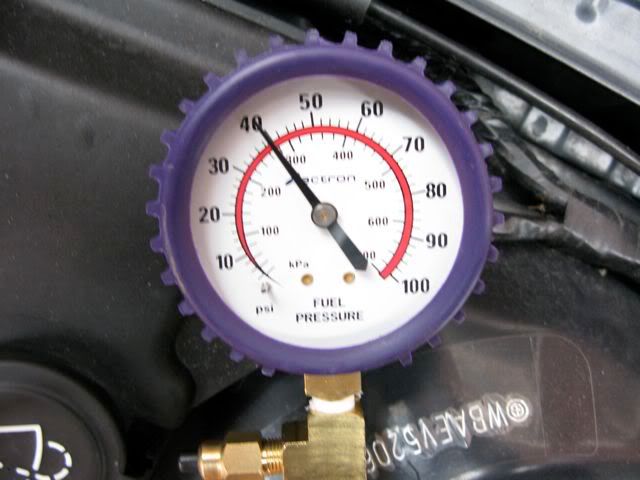
After 3 minutes...
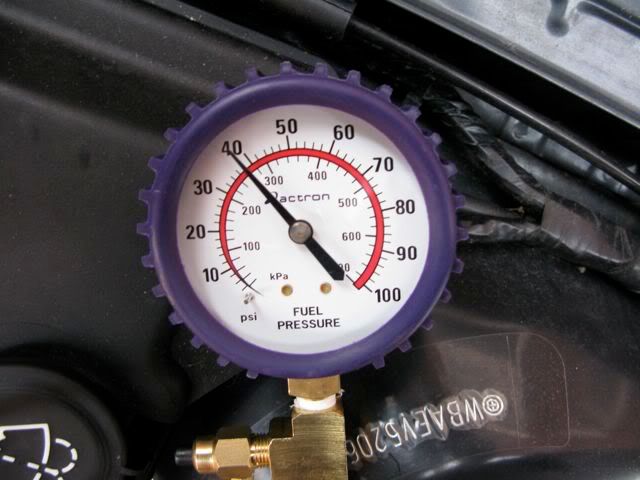
After 4 minutes...
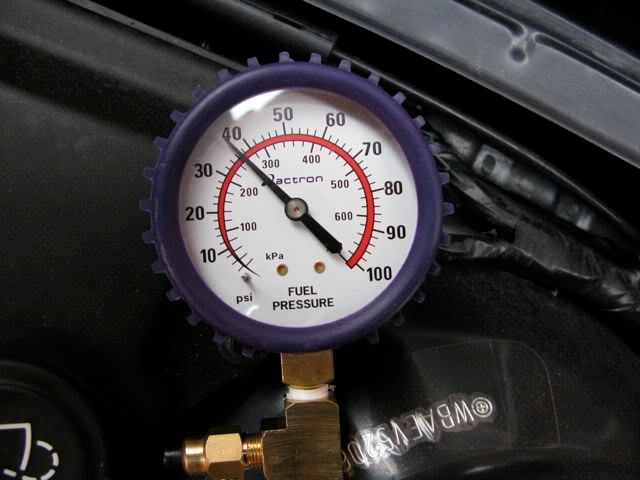
After 5 minutes...
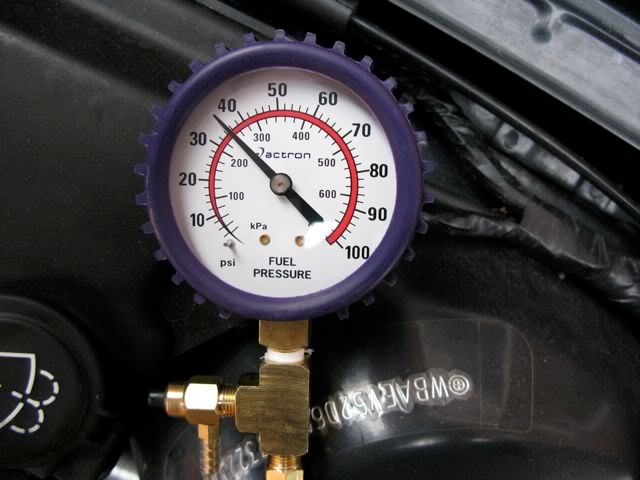
After 10 minutes...
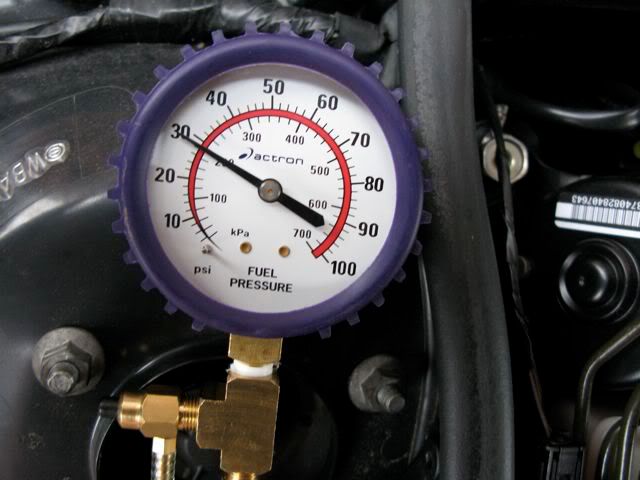
After 30 minutes...
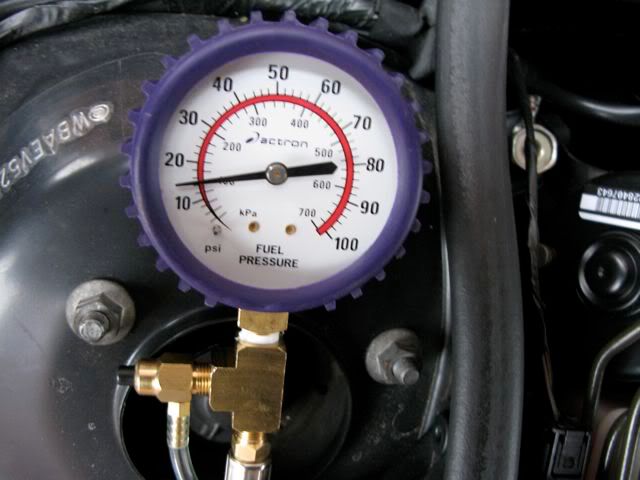
So as we can see, pretty serious amounts of fuel pressure loss.
I am quite confident it is not the fuel filter/pressure regulator as I changed this last June and the symptoms existed before and after the change.
I think my next step will be to take the fuel rail out with the injectors in place and prime the fuel pump and check for leakage from the injectors.
My current theory is injectors leaking which creates the hard starting and the blipping of throttle helps the start as it adds more air to the mix which is required due to the excess fuel.
I wondered if the fuel pump might be an issue too.
Any input on next steps I should take would be welcome.
When the car is stone cold (left for 2 days), it starts perfectly
When the car is cold (left overnight), it starts more or less perfectly, only a slight blip when turning the key
When the car is warm (left more than 5 minutes after turning the ignition off), it becomes harder to start with longer crank times
When the car is warm (left around 3 hours), it becomes very difficult to start with around 5 seconds crank time, and having to use the throttle to get the car started/idling perfectly. (It fires weakly into life but RPM sits around 200-400 RPM, and it needs a blip of the throttle to get to the 650 RPM range where it is then happy)
The car seems fine apart from this annoyance.
At this stage I should add that I have had the car scanned many times including by BMW GT1 scanner and no codes are thrown at all.
In the last year I have changed the fuel filter, crankcase vent valve and all hoses, cleaned the ICV, Throttle body, changed the hoses from MAF down to throttle body/ICV, changed the VANOS seals with the beisan kit and changed all gaskets whilst doing that, serviced the car fully included all filters, oil etc. Changed the transmission and diff oil. Changed the spark plugs. Changed intake and exhaust cam sensors, inspite of no codes being shown, just in case.
So after all that I decided to invest in a fuel pressure gauge and ordered a unit from the US which arrived late last week.
I've just been out to the car to carry out some readings. As far as I am aware (please correct me if I am wrong), the fuel pressure should be 3.5 bar (broadly 50.8 PSI) when the rail is primed by the fuel pump and as far as I am aware there should not be significant degradation in fuel pressure for a good while (I understand 2 hours) after the fuel pump has primed the system.
The fuel pressure gauge attaches to the schraeder valve on the fuel rail as such...

When the car is turned on and idling, the pressure reads broadly what I was expecting...

So after this, I switched the car off and then went through a couple of cycles of priming the fuel rail with the whirring of the fuel pump and quickly got a photo of the pressure...

Already in a short time I see the fuel pressure dropping.
After 1 minute we have...

Quite a significant drop in fuel pressure, after 2 minutes we have...

After 3 minutes...

After 4 minutes...

After 5 minutes...

After 10 minutes...

After 30 minutes...

So as we can see, pretty serious amounts of fuel pressure loss.
I am quite confident it is not the fuel filter/pressure regulator as I changed this last June and the symptoms existed before and after the change.
I think my next step will be to take the fuel rail out with the injectors in place and prime the fuel pump and check for leakage from the injectors.
My current theory is injectors leaking which creates the hard starting and the blipping of throttle helps the start as it adds more air to the mix which is required due to the excess fuel.
I wondered if the fuel pump might be an issue too.
Any input on next steps I should take would be welcome.
Edited by Neil_Sc on Saturday 13th March 18:09
Good diagnostics so far. I don't have E46 specs to had but for the E36 BMW states the pressure should not drop more than 0.5 bar in the 20 minutes after fuel pump shut-off. Bear in mind pressure will drop when the engine is shut off as the engine is no longer pulling a vacuum on the connection to the FPR.
Have diagnostics ever been connected during one of the problematic hot starts? The diagnostics should be able to identify which cylinder(s) are not "contributing" to the running of the car and would help narrow down which injectors might be the problem.
If you do pull the fuel rail best to get a new set of injector O rings and a few spare clips that hold the injectors to the rail.
Have diagnostics ever been connected during one of the problematic hot starts? The diagnostics should be able to identify which cylinder(s) are not "contributing" to the running of the car and would help narrow down which injectors might be the problem.
If you do pull the fuel rail best to get a new set of injector O rings and a few spare clips that hold the injectors to the rail.
phelix said:
Good diagnostics so far. I don't have E46 specs to had but for the E36 BMW states the pressure should not drop more than 0.5 bar in the 20 minutes after fuel pump shut-off. Bear in mind pressure will drop when the engine is shut off as the engine is no longer pulling a vacuum on the connection to the FPR.
Have diagnostics ever been connected during one of the problematic hot starts? The diagnostics should be able to identify which cylinder(s) are not "contributing" to the running of the car and would help narrow down which injectors might be the problem.
If you do pull the fuel rail best to get a new set of injector O rings and a few spare clips that hold the injectors to the rail.
Thanks for the input, yes I was just thinking about new o rings and clips, I do have access to a diagnostics machine, so will no doubt try that next along with pulling the fuel rail.Have diagnostics ever been connected during one of the problematic hot starts? The diagnostics should be able to identify which cylinder(s) are not "contributing" to the running of the car and would help narrow down which injectors might be the problem.
If you do pull the fuel rail best to get a new set of injector O rings and a few spare clips that hold the injectors to the rail.
Thought I'd update this, a few weekends ago I did some further diagnosis on this problem.
Originally I was planning to clamp the fuel hose coming into the fuel rail immediately after priming the rail to see if the pressure still leaked away or if it remained.
The theory being, if the pressure continued to decrease, I may have an injector leak.
Unfortunately the non existent access between the engine block and the firewall ruled this plan out.
I now decided to take out the fuel rail and put some shop towel under the injectors, prime the rail and check for leaks.
It's a bit of a pain in the arse to remove the fuel rail, the only real reason being the little clips that hold the fuel rail to the injectors, access particularly to the injectors at the rear of the engine block is minimal.
I started off by removing the injectors totally, remembering which injector came from which cylinder and giving them a clean with a little isopropynol

I did this because I had new o-rings from BMW to put on the injectors, after doing this I attached them back to the rail and attached my fuel pressure tester to the shraeder valve and liberally placed shop towel under the fuel rail. After priming the fuel rail and checking pressure I found absolutely no leaks from the injectors.


The next plan is to clamp the return hose from the fuel filter after priming the fuel rail to see if that has any impact.
I replaced the fuel filter last year, albeit with a non genuine filter. I think the plan of action after this test will be to replace the filter and then if that doesn't help, replace the fuel pump.
Originally I was planning to clamp the fuel hose coming into the fuel rail immediately after priming the rail to see if the pressure still leaked away or if it remained.
The theory being, if the pressure continued to decrease, I may have an injector leak.
Unfortunately the non existent access between the engine block and the firewall ruled this plan out.
I now decided to take out the fuel rail and put some shop towel under the injectors, prime the rail and check for leaks.
It's a bit of a pain in the arse to remove the fuel rail, the only real reason being the little clips that hold the fuel rail to the injectors, access particularly to the injectors at the rear of the engine block is minimal.
I started off by removing the injectors totally, remembering which injector came from which cylinder and giving them a clean with a little isopropynol

I did this because I had new o-rings from BMW to put on the injectors, after doing this I attached them back to the rail and attached my fuel pressure tester to the shraeder valve and liberally placed shop towel under the fuel rail. After priming the fuel rail and checking pressure I found absolutely no leaks from the injectors.


The next plan is to clamp the return hose from the fuel filter after priming the fuel rail to see if that has any impact.
I replaced the fuel filter last year, albeit with a non genuine filter. I think the plan of action after this test will be to replace the filter and then if that doesn't help, replace the fuel pump.
"I replaced the fuel filter last year, albeit with a non genuine filter"
You waited a long time to tell us this! My local MB/BMW independent had a Kompressor recently that wouldn't idle or pull properly. Swopping the new non-Mercedes filter for an MB part made it run perfectly. The filter had four connections on it
There's no particular reason that the BMW would suffer the same way but I'd change the filter just to be sure
Nick Froome
You waited a long time to tell us this! My local MB/BMW independent had a Kompressor recently that wouldn't idle or pull properly. Swopping the new non-Mercedes filter for an MB part made it run perfectly. The filter had four connections on it
There's no particular reason that the BMW would suffer the same way but I'd change the filter just to be sure
Nick Froome
bolide said:
"I replaced the fuel filter last year, albeit with a non genuine filter"
You waited a long time to tell us this! My local MB/BMW independent had a Kompressor recently that wouldn't idle or pull properly. Swopping the new non-Mercedes filter for an MB part made it run perfectly. The filter had four connections on it
There's no particular reason that the BMW would suffer the same way but I'd change the filter just to be sure
Nick Froome
The reason I hadn't changed the filter earlier was that I still had the problem pre filter swap, I changed the filter originally to try and address the issue, but I do think it is worth revisiting before looking at the fuel pump.You waited a long time to tell us this! My local MB/BMW independent had a Kompressor recently that wouldn't idle or pull properly. Swopping the new non-Mercedes filter for an MB part made it run perfectly. The filter had four connections on it
There's no particular reason that the BMW would suffer the same way but I'd change the filter just to be sure
Nick Froome
I realise that you're not getting any fault codes - but have a read of this thread.
Tony, I looked at those posts. Makes sense.
To be able to verify this is the issue, I could just open my gas cap and close it again, if it releases the negative pressure, it would mean this part could be bad. Also after releasing the pressure, the engine should have no start-up issues.
Does that sound right? It is Monday :-).
I am going to try this and keep you posted.
Thanks.
To be able to verify this is the issue, I could just open my gas cap and close it again, if it releases the negative pressure, it would mean this part could be bad. Also after releasing the pressure, the engine should have no start-up issues.
Does that sound right? It is Monday :-).
I am going to try this and keep you posted.
Thanks.
exnoodle said:
Tony, I looked at those posts. Makes sense.
To be able to verify this is the issue, I could just open my gas cap and close it again, if it releases the negative pressure, it would mean this part could be bad. Also after releasing the pressure, the engine should have no start-up issues.
Does that sound right? It is Monday :-).
I am going to try this and keep you posted.
Thanks.
Sounds feasible to me. Although on a warm day you'll likely have a small pressure build up I would have thought.To be able to verify this is the issue, I could just open my gas cap and close it again, if it releases the negative pressure, it would mean this part could be bad. Also after releasing the pressure, the engine should have no start-up issues.
Does that sound right? It is Monday :-).
I am going to try this and keep you posted.
Thanks.
I carried out the test on the return hose from the fuel filter today. The clamp I used couldn't fully clamp the return hose shut, but by restricting the flow I hoped to show a difference between doing the test without the hose being clamped and with the hose clamped.
I attached my fuel pressure gauge to the fuel rail and started each test by priming the fuel rail by moving the ignition to the position just before engine start.
With no clamp affixed to the return pipe I recorded
1 min - 44 psi
2 min - 41 psi
3 min - 38 psi
5 min - 35.5 psi
7 min = 32.5 psi
9 min = 31 psi
10 min = 30 psi
15 min = 26 psi
I repeated this test by priming the rail and then running around to the passenger side and affixing the clamp to the return hose as per the photo. As you can see it isn't fully clamped, but the flow should be restricted.

The results recorded were
1 min - 46 psi
2 min - 44 psi
3 min - 42.5 psi
5 min - 39.5 psi
7 min = 36 psi
9 min = 33.5 psi
10 min = 32 psi
15 min = 28 psi
The difference wasn't huge, but then the line wasn't fully clamped. I did repeat for a third time and this time got under the car and tried to hold the clamp even tighter for a few minutes, the result was a reading of 40 PSI after 5 minutes, so slightly more fuel retained.
I think this is pointing to the check valve in the fuel pump being knackered.
I attached my fuel pressure gauge to the fuel rail and started each test by priming the fuel rail by moving the ignition to the position just before engine start.
With no clamp affixed to the return pipe I recorded
1 min - 44 psi
2 min - 41 psi
3 min - 38 psi
5 min - 35.5 psi
7 min = 32.5 psi
9 min = 31 psi
10 min = 30 psi
15 min = 26 psi
I repeated this test by priming the rail and then running around to the passenger side and affixing the clamp to the return hose as per the photo. As you can see it isn't fully clamped, but the flow should be restricted.

The results recorded were
1 min - 46 psi
2 min - 44 psi
3 min - 42.5 psi
5 min - 39.5 psi
7 min = 36 psi
9 min = 33.5 psi
10 min = 32 psi
15 min = 28 psi
The difference wasn't huge, but then the line wasn't fully clamped. I did repeat for a third time and this time got under the car and tried to hold the clamp even tighter for a few minutes, the result was a reading of 40 PSI after 5 minutes, so slightly more fuel retained.
I think this is pointing to the check valve in the fuel pump being knackered.
Gassing Station | BMW General | Top of Page | What's New | My Stuff



